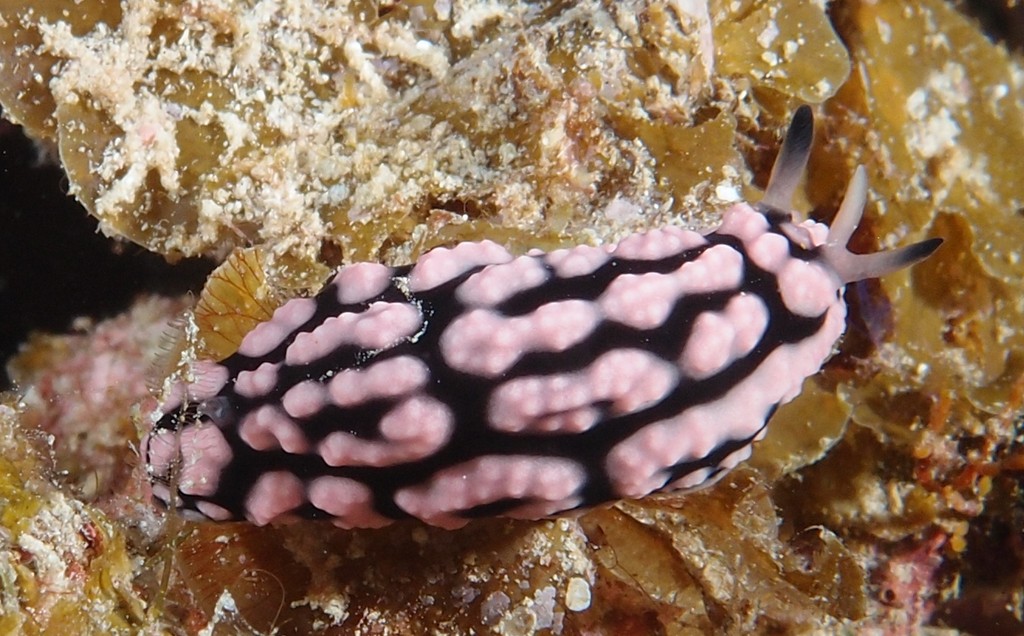PHYLLIDIELLA PUSTULOSA - (CUVIER, 1804)
Opisthobranchia (Infraclass) > Nudibranchia (Order) > Euctenidiacea (Suborder) > Doridacea (Infraorder) > Phyllidioidea (Superfamily) > Phyllidiidae (Family) > Phyllidiella (Genus)
Phyllidie pustuleuse, vesicular sea slug, pustular phyllidia
Description
La phyllidie pustuleuse est de couleur généralement rose pâle ou parfois gris clair avec des verrues réparties irrégulièrement sur le corps entourées de noir. Ses rhinophores sont noirs, et à la base de chacun d'eux, le fourreau des juvéniles est rose et noir chez les adultes. Le dessous du pied est blanc à gris clair. Le corps est allongé et limaciforme. Possibilité mais pas nécessaire, d'avoir un liseré rose à mauve en bordure périphérique du manteau à la base du pied. Les rhinophores sont lamellés,rétractiles et de teinte noire.
Biotope
Phyllidiella pustulosa vit dans le biotope suivant : fonds rocheux ou coralliens.
Particularités
La ponte de Phyllidiella pustulosa est blanche. Cette Phyllidie est benthique et diurne.
Synonymes
Fryeria variabilis (Collingwood, 1881)
Phyllidia albonigra (Quoy & Gaimard, 1832)
Phyllidia melanocera (Yonow, 1986)
Phyllidia pustulosa (Cuvier, 1804)
Phyllidia rotunda (Eliot, 1904)
Phyllidia spectabilis (Collingwood, 1881)
Phyllidia verrucosa (van Hasselt, 1824)
Phyllidiella nobilis (Bergh, 1869)
----------------------
Maximum size
About 51 mm (Hoover, 2006).
Identification
This species is elongate with low, irregularly-shaped clusters of smooth, conical pink tubercles on a black notum. The tubercles are usually simple and grouped in clusters with little or no black showing within the cluster. The mantle margin is edged in pale pink and the rhinophores are black. When seen underwater with the human eye, the animal may appear to have gray-green tubercles against a black background due to the absence of red light in deeper water. It can be distinguished from the rarely-seen Phyllidiopsis fissuratus by its continuous pink marginal line and solid black rhinophores.
Natural history
Phyllidiella pustulosa is commonly found in the open in rocky habitats. It lives in moderately protected to highly exposed areas at depths of 4-26 m (13-85 ft). It has been observed feeding on an orange encrusting sponge of the genus Stylinos.
Distribution
Widely distributed in the Indo-Pacific - Present in New Caledonia.
Taxonomic notes
This is the species listed as Fryeria ruppelli Bergh, 1889b in Kay, 1979 and as Phyllidia pustulosa in Bertsch and Johnson, 1981. The name means "full of pustules" referring to the many pink tubercles. It is referred to as the "pustulose Phyllidia" in Hoover, 1998 & 2006.
Phyllidie pustuleuse, vesicular sea slug, pustular phyllidia
Description
La phyllidie pustuleuse est de couleur généralement rose pâle ou parfois gris clair avec des verrues réparties irrégulièrement sur le corps entourées de noir. Ses rhinophores sont noirs, et à la base de chacun d'eux, le fourreau des juvéniles est rose et noir chez les adultes. Le dessous du pied est blanc à gris clair. Le corps est allongé et limaciforme. Possibilité mais pas nécessaire, d'avoir un liseré rose à mauve en bordure périphérique du manteau à la base du pied. Les rhinophores sont lamellés,rétractiles et de teinte noire.
Biotope
Phyllidiella pustulosa vit dans le biotope suivant : fonds rocheux ou coralliens.
Particularités
La ponte de Phyllidiella pustulosa est blanche. Cette Phyllidie est benthique et diurne.
Synonymes
Fryeria variabilis (Collingwood, 1881)
Phyllidia albonigra (Quoy & Gaimard, 1832)
Phyllidia melanocera (Yonow, 1986)
Phyllidia pustulosa (Cuvier, 1804)
Phyllidia rotunda (Eliot, 1904)
Phyllidia spectabilis (Collingwood, 1881)
Phyllidia verrucosa (van Hasselt, 1824)
Phyllidiella nobilis (Bergh, 1869)
----------------------
Maximum size
About 51 mm (Hoover, 2006).
Identification
This species is elongate with low, irregularly-shaped clusters of smooth, conical pink tubercles on a black notum. The tubercles are usually simple and grouped in clusters with little or no black showing within the cluster. The mantle margin is edged in pale pink and the rhinophores are black. When seen underwater with the human eye, the animal may appear to have gray-green tubercles against a black background due to the absence of red light in deeper water. It can be distinguished from the rarely-seen Phyllidiopsis fissuratus by its continuous pink marginal line and solid black rhinophores.
Natural history
Phyllidiella pustulosa is commonly found in the open in rocky habitats. It lives in moderately protected to highly exposed areas at depths of 4-26 m (13-85 ft). It has been observed feeding on an orange encrusting sponge of the genus Stylinos.
Distribution
Widely distributed in the Indo-Pacific - Present in New Caledonia.
Taxonomic notes
This is the species listed as Fryeria ruppelli Bergh, 1889b in Kay, 1979 and as Phyllidia pustulosa in Bertsch and Johnson, 1981. The name means "full of pustules" referring to the many pink tubercles. It is referred to as the "pustulose Phyllidia" in Hoover, 1998 & 2006.
